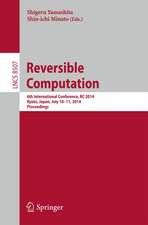Accelerator Data-Path Synthesis for High-Throughput Signal Processing Applications
Autor Werner Geurts, Francky Catthoor, Serge Vernalde, Hugo De Manen Limba Engleză Paperback – 5 sep 2012
Accelerator Data-Path Synthesis for High-Throughput Signal Processing Applications focuses on domains where application-specific high-speed solutions are attractive such as significant parts of audio, telecom, instrumentation, speech, robotics, medical and automotive processing, image and video processing, TV, multi-media, radar, sonar, etc. Moreover, it addresses mainly the steps above the traditional scheduling and allocation tasks which focus on scalar operations and data.
Accelerator Data-Path Synthesis for High-Throughput Signal Processing Applications is of interest to researchers, senior design engineers and CAD managers both in academia and industry. It provides an excellent overview of what capabilities to expect from future practical design tools and includes an extensive bibliography.
| Toate formatele și edițiile | Preț | Express |
|---|---|---|
| Paperback (1) | 943.73 lei 6-8 săpt. | |
| Springer Us – 5 sep 2012 | 943.73 lei 6-8 săpt. | |
| Hardback (1) | 950.03 lei 6-8 săpt. | |
| Springer Us – 30 noi 1996 | 950.03 lei 6-8 săpt. |
Preț: 943.73 lei
Preț vechi: 1150.89 lei
-18% Nou
Puncte Express: 1416
Preț estimativ în valută:
180.59€ • 193.11$ • 150.57£
180.59€ • 193.11$ • 150.57£
Carte tipărită la comandă
Livrare economică 18 aprilie-02 mai
Preluare comenzi: 021 569.72.76
Specificații
ISBN-13: 9781461346746
ISBN-10: 1461346746
Pagini: 263
Ilustrații: XIV, 263 p.
Dimensiuni: 160 x 240 x 17 mm
Greutate: 0.4 kg
Ediția:1997
Editura: Springer Us
Colecția Springer
Locul publicării:New York, NY, United States
ISBN-10: 1461346746
Pagini: 263
Ilustrații: XIV, 263 p.
Dimensiuni: 160 x 240 x 17 mm
Greutate: 0.4 kg
Ediția:1997
Editura: Springer Us
Colecția Springer
Locul publicării:New York, NY, United States
Public țintă
ResearchCuprins
1 Introduction.- 1.1 Design of ASICs for high-throughput RSP.- 1.2 Overview and contributions of the book.- 2 Applications and Architecture.- 2.1 Characteristics of the application domain.- 2.2 The architectural style.- 2.3 Summary.- 3 The Underlying Synthesis Data Models.- 3.1 Operations and building blocks.- 3.2 Signal flow graph related issues.- 3.3 Summary.- 4 Literature Study.- 4.1 Traditional synthesis.- 4.2 Synthesis with accelerator data paths.- 4.3 Conclusions.- 5 The HLDM Script.- 5.1 The Cathedral-3 script.- 5.2 A script based approach.- 5.3 Initial flow graph transformations.- 5.4 ASU synthesis tasks.- 5.5 Motivation for the script.- 5.6 Synthesis of homogeneous architectures.- 5.7 Summary.- 6 Operation Clustering.- 6.1 Motivation.- 6.2 Related work.- 6.3 Operation clusters.- 6.4 Clustering techniques.- 6.5 Summary.- 7 Cluster to ASU Assignment.- 7.1 The cluster compatibility model.- 7.2 Solution techniques.- 7.3 Assignment in the presence of loops.- 7.4 Extensions.- 7.5 Summary.- 8 ASU Synthesis.- 8.1 The merging problem.- 8.2 Merging of a pair of structures.- 8.3 Extensions of pairwise merging.- 8.4 Ordering schemes for pairwise merging.- 8.5 N-way merging by iterative improvement.- 8.6 Summary.- 9 Demonstrator Designs.- 9.1 A 2 MHz ISDN modem.- 9.2 DCT/IDCT design for a videophone application.- 9.3 Address generation for a 2D motion estimator.- 9.4 Conclusions.- 10 Conclusions.- 10.1 Motivation of our approach.- 10.2 Contributions.- 10.3 Further work.- A Timing Analysis on Flow Graphs.- A.1 The model.- A.2 Timing vector algebra.- A.3 The critical path algorithm.- B The Constructive Clustering Algorithms.- B.1 Definitions.- B.2 Algorithms.- C Algorithms of the Assignment Chapter.- D Assignment Benchmarks.- D.1 The Silage code.- D.2 The results.- E Proof ofTheorem 8.1..- F ASU Synthesis Benchmarks.- F.1 Results for the pair-merging techniques.- F.2 Results for the ordering schemes.- F.3 Area correlation.- References.
























